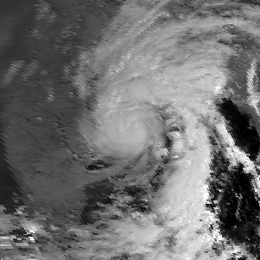1995 India cyclone
| Very severe cyclonic storm (IMD scale) | |
|---|---|
| Category 1 (Saffir–Simpson scale) | |

Satellite image of the storm near landfall
|
|
| Formed | November 7, 1995 |
| Dissipated | November 11, 1995 |
| Highest winds |
3-minute sustained: 120 km/h (75 mph) 1-minute sustained: 130 km/h (80 mph) |
| Lowest pressure | 978 hPa (mbar); 28.88 inHg |
| Fatalities | 236 overall |
| Damage | $46.3 million (1995 USD) |
| Areas affected | India, Bangladesh, Nepal |
| Part of the 1995 North Indian Ocean cyclone season | |
In November 1995, a tropical cyclone struck southeastern India and later spawned a rare snowstorm in Nepal, triggering the deadliest mountain trekking incident in the country's history. The storm originated from the monsoon trough on November 7 in the Bay of Bengal, east of India, becoming the penultimate storm of the 1995 North Indian Ocean cyclone season. Moving northwestward, the system gradually intensified while moving toward land, eventually developing an eye in the middle of the convection. Reaching peak winds of at least 120 km/h (75 mph), the India Meteorological Department (IMD) classified the system as a very severe cyclonic storm on November 8, in line with intensity estimates from the American-based Joint Typhoon Warning Center (JTWC). On November 9, the cyclone made landfall near the border of Andhra Pradesh and Orissa. Atypical for most November storms, the system continued to the north and dissipated over Nepal on November 11.
In India, the cyclone's strong winds were accompanied by heavy rainfall and a storm surge of 1.5 m (4.9 ft) that inundated the coastline several hundred feet inland. Power lines, crops, and houses were damaged, and many boats were damaged, causing several nautical fatalities. The cyclone killed at least 128 people in India, with hundreds remaining unaccounted for, and damage was estimated at RS$1.1 billion (US$ 32.2 million). In neighboring Bangladesh, high waves killed 45 people after sinking or sweeping away four ships. The cyclone later spawned a rare November snowstorm across eastern Nepal, with depths reaching 2,000 mm (79 in). The snowfall occurred without warning amid the busy mountain trekking season, and there were several avalanches and landslides across the country. One such incident killed 24 people at a lodge near Gokyo, and there were 63 deaths related to the cyclone in the country. The Nepal government launched the largest search and rescue mission in the country's history, rescuing 450 people, some of whom trapped for days in the snow.
...
Wikipedia
